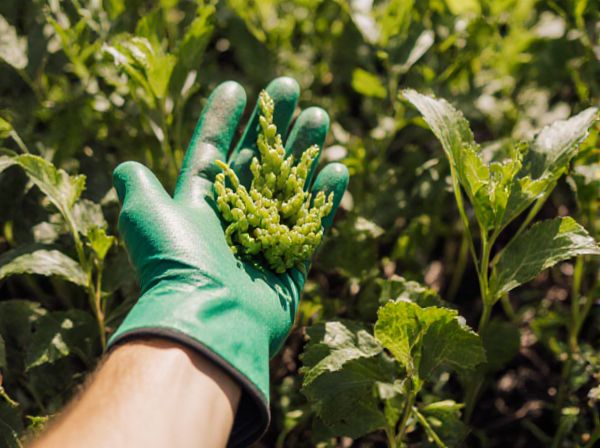
Legumes vs Nightshades Illustration
Companion planting with legumes improves soil nitrogen levels, benefiting nearby plants, while nightshades often require careful placement due to their susceptibility to pests and diseases. Legumes such as beans and peas fix nitrogen in the soil, promoting healthier growth for surrounding crops. Nightshades like tomatoes and peppers thrive when planted away from legumes to prevent nutrient competition and reduce the risk of spreading pathogens.
Table of Comparison
| Aspect | Legumes | Nightshades |
|---|---|---|
| Definition | Plants in the Fabaceae family, producing pods with seeds. | Plants in the Solanaceae family, often containing alkaloids. |
| Common Examples | Beans, lentils, peas, chickpeas. | Tomatoes, potatoes, eggplants, peppers. |
| Nutritional Profile | High in protein, fiber, folate, and iron. | Rich in vitamins A, C, potassium, and antioxidants. |
| Culinary Uses | Staples in soups, salads, stews, and curries. | Used in sauces, stir-fries, salads, and side dishes. |
| Health Considerations | May cause digestive issues if not soaked or cooked properly. | Contains alkaloids; some individuals may be sensitive or allergic. |
| Growth Habit | Generally nitrogen-fixing, improve soil fertility. | Non-nitrogen fixing, often sensitive to frost. |
Introduction to Legumes and Nightshades
Legumes, including beans, lentils, and peas, are a group of plants known for their nitrogen-fixing ability and high protein content, making them essential in companion planting for soil enrichment. Nightshades, such as tomatoes, peppers, and eggplants, are a diverse family of flowering plants that often require specific companion crops to enhance growth and deter pests. Understanding the characteristics and interactions of legumes and nightshades is crucial for optimizing garden productivity and sustainability.
Key Differences Between Legumes and Nightshades
Legumes, such as beans, lentils, and peas, belong to the Fabaceae family and are known for their high protein and fiber content, which make them excellent companions in crop rotation for nitrogen fixation. Nightshades, including tomatoes, potatoes, and eggplants, are part of the Solanaceae family and often contain alkaloids that can be toxic to some people, affecting their suitability for companion planting. The key differences lie in their botanical classification, nutritional profiles, and chemical compositions, which influence their roles and compatibility in garden ecosystems.
Nutritional Benefits of Legumes
Legumes are rich sources of plant-based protein, dietary fiber, and essential nutrients such as iron, magnesium, and folate, which promote heart health and aid digestion. Unlike nightshades, legumes contain low levels of lectins and alkaloids, making them easier to digest and less likely to cause inflammation. Consuming legumes supports blood sugar regulation and provides antioxidants that help reduce the risk of chronic diseases.
Health Impacts of Nightshade Vegetables
Nightshade vegetables, including tomatoes, potatoes, and eggplants, contain alkaloids such as solanine, which may trigger inflammation or digestive issues in sensitive individuals. Research indicates that excessive consumption of nightshades can exacerbate symptoms of autoimmune conditions like arthritis due to their potential to increase inflammatory responses. Despite these concerns, nightshades are rich in essential nutrients like vitamins A and C, antioxidants that support overall health when consumed in moderation.
Common Legumes for Your Garden
Common legumes for your garden, such as peas, beans, and lentils, enrich soil nitrogen through symbiotic nitrogen fixation, enhancing plant growth and health. Unlike nightshades, legumes contribute to sustainable gardening by improving soil fertility and supporting beneficial soil microbes. Incorporating legumes into crop rotation reduces the need for chemical fertilizers and promotes biodiversity in your garden ecosystem.
Popular Nightshades to Grow at Home
Popular nightshades to grow at home include tomatoes, peppers, and eggplants, offering vibrant flavors and rich nutritional profiles. These plants thrive in well-drained soil with ample sunlight, making them ideal for home gardens aiming for diverse, nutrient-dense produce. Unlike legumes, nightshades require consistent warmth and moderate watering to maximize yield and fruit quality.
Companion Planting: Legumes and Nightshades
Legumes, such as beans and peas, enrich soil nitrogen through symbiotic bacteria, enhancing the growth of nightshades like tomatoes and peppers by improving nutrient availability. Nightshades benefit from legumes' nitrogen fixation, which supports higher yields and healthier plants in companion planting systems. This mutualistic relationship optimizes garden ecosystems by promoting soil fertility and reducing the need for synthetic fertilizers.
Managing Pests and Diseases in Legumes vs Nightshades
Managing pests and diseases in legumes involves targeting common threats such as aphids, root-knot nematodes, and powdery mildew, while nightshades often face challenges from tomato hornworms, spider mites, and late blight. Legumes benefit from nitrogen-fixing bacteria that improve soil health and reduce susceptibility to certain pathogens, whereas nightshades require vigilant monitoring and crop rotation to prevent soil-borne diseases. Integrating biological controls and resistant cultivars enhances pest and disease management efficacy in both plant families.
Soil and Climate Requirements for Each Group
Legumes thrive in well-drained, loamy soils with moderate fertility and prefer temperate to tropical climates that support nitrogen fixation symbiosis. Nightshades require fertile, well-drained soils rich in organic matter and exhibit optimal growth in warm, frost-free environments with consistent moisture. Understanding these distinct soil and climate needs enhances companion planting success by optimizing mutual growth conditions.
Choosing Between Legumes and Nightshades for Your Garden
Choosing between legumes and nightshades for your garden depends on soil enrichment and pest management needs. Legumes, such as peas and beans, enhance nitrogen levels through nitrogen-fixing bacteria, improving soil fertility naturally. Nightshades like tomatoes and peppers require nutrient-rich soil and offer diverse harvests but may attract specific pests, making companion planting strategies essential.
Legumes vs Nightshades Infographic

 gardendif.com
gardendif.com